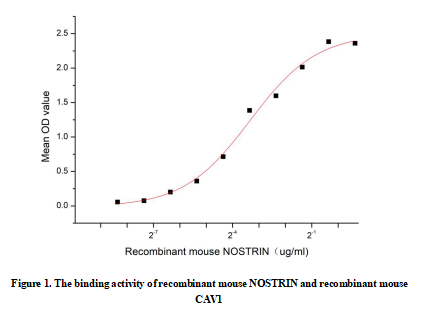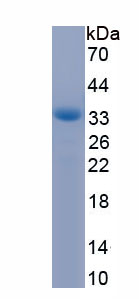Active Nitric Oxide Synthase Trafficker (NOSTRIN) 

BM247 homolog; Nitric oxide synthase traffic inducer; eNOS-trafficking inducer
- UOM
- FOB US$ 282.00 US$ 705.00 US$ 1,410.00 US$ 4,230.00 US$ 10,575.00
- Quantity
Overview
Properties
- Product No.APA628Mu01
- Organism SpeciesMus musculus (Mouse) Same name, Different species.
- ApplicationsCell culture; Activity Assays.
Research use only - DownloadInstruction Manual
- CategoryMetabolic pathwayInfection immunityCardiovascular biologyNeuro science
- Buffer FormulationPBS, pH7.4, containing 0.01% SKL, 5% Trehalose.
- Traits Freeze-dried powder, Purity > 95%
- Isoelectric Point9.6
Sign into your account
Share a new citation as an author
Upload your experimental result
Review

Contact us
Please fill in the blank.
Activity test

Nitric Oxide Synthase Trafficker, abbreviated as NOSTRIN, is a protein that plays a role in the regulation of nitric oxide synthase (NOS) activity. NOSTRIN is involved in the internalization and trafficking of endothelial NOS (eNOS) from the plasma membrane to intracellular compartments, which affects the production of nitric oxide (NO). NO is a signaling molecule that has a variety of physiological functions, including the regulation of blood pressure and vascular tone. By modulating the localization and activity of eNOS, NOSTRIN can influence these processes. NOSTRIN is expressed in various tissues, with particularly high levels in the endothelium, and its expression is regulated by factors such as shear stress and inflammatory cytokines. Alterations in NOSTRIN function have been implicated in several cardiovascular diseases.Caveolin 1 (CAV1) is a protein that is known to interact with NOSTRIN. This interaction is significant in various cellular processes, including the regulation of lipid metabolism and signal transduction pathways. Thus a functional ELISA assay was conducted to detect the interaction of recombinant mouse NOSTRIN and recombinant mouse CAV1. Briefly, NOSTRIN was diluted serially in PBS with 0.01% BSA (pH 7.4). Duplicate samples of 100 μl were then transferred to CAV1-coated microtiter wells and incubated for 1h at 37℃. Wells were washed with PBST and incubated for 1h with anti-NOSTRIN pAb, then aspirated and washed 3 times. After incubation with HRP labelled secondary antibody for 1h at 37℃, wells were aspirated and washed 5 times. With the addition of substrate solution, wells were incubated 15-25 minutes at 37℃. Finally, add 50 µL stop solution to the wells and read at 450/630nm immediately. The binding activity of recombinant mouse NOSTRIN and recombinant mouse CAV1 was shown in Figure 1, the EC50 for this effect is 0.10ug/mL.
Usage
Reconstitute in 10mM PBS (pH7.4) to a concentration of 0.1-1.0 mg/mL. Do not vortex.
Storage
Avoid repeated freeze/thaw cycles. Store at 2-8°C for one month. Aliquot and store at -80°C for 12 months.
Stability
The thermal stability is described by the loss rate. The loss rate was determined by accelerated thermal degradation test, that is, incubate the protein at 37°C for 48h, and no obvious degradation and precipitation were observed. The loss rate is less than 5% within the expiration date under appropriate storage condition.
Increment services
-
 BCA Protein Quantification Kit
BCA Protein Quantification Kit
-
 Molecular Mass Marker for Protein
Molecular Mass Marker for Protein
-
 Monoclonal Antibody Customized Service
Monoclonal Antibody Customized Service
-
 Polyclonal Antibody Customized Service
Polyclonal Antibody Customized Service
-
 Protein Activity Test Experiment Service
Protein Activity Test Experiment Service
-
 Electrophoretic Mobility Shift Assay (EMSA) Experiment Service
Electrophoretic Mobility Shift Assay (EMSA) Experiment Service
-
 Buffer
Buffer
-
 Lentivirus Packaging Experiment Service
Lentivirus Packaging Experiment Service
-
 Adenovirus Packaging Experiment Service
Adenovirus Packaging Experiment Service
-
 Real Time PCR Experimental Service
Real Time PCR Experimental Service
-
 Spike RBD Protein (S-RBD)
Spike RBD Protein (S-RBD)
-
 Protein G
Protein G
-
 Protein A
Protein A
Citations
- The pathogenetic importance of C774T single nucleotide polymorphism of the endothelial nitric oxide synthase gene in the development of metabolic syndromearticle:10.1134







